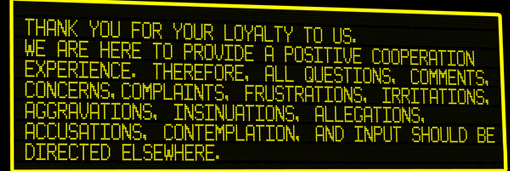
Many companies are looking to improve their customer experience. To help you with a few ideas we asked a number of our readers for their tips on how to improve customer experience.
1. Extend your voice of the customer programme
Extend your voice of the customer (VOC) programme from one-dimensional satisfaction scores to in-depth qualitative interaction. There is a growing set of online facilities being set up by brands to encourage customer feedback and co-design of the service experience. This can also be done in the call centre through prompted questions to invite unstructured feedback which is then mined using speech analytics.
Martin Hill-Willson, Datapoint (www.datapoint.com)
—————–
2. Stop typing, start listening
Make sure that your agents don’t type when they’re on the phone with a customer. That way they’re actually listening.
Sent in by Twitter from 1to1Media http://twitter.com/1to1Media
—————-
3. Try customer experience management
Customer experience management (CEM) should be the way and why of all you do. It should not be a discrete activity, programme or a functional department.
4. Expectations are a moving target
Ongoing alignment is necessary because expectations are a moving target. Innovations, competitors’ moves, and economic and social trends are some of the forces that cause continual morphing of customers’ expectations.
5. True customer-centricity
True customer-centricity is a consistent practice of looking at things from the customer’s point of view, and making decisions accordingly. To be customer-centric, everyone inside a company should gain a thorough understanding of customer expectations, monitor customer data relevant to their role, and use it to make a difference on a continuous basis.
6. Ripple effect
The ripple effect of any internal organisation’s actions is ultimately felt by a firm’s customer-facing professionals, and typically by the customers as well. Negative ripples are manifest to customers as hassles, disappointments, annoyances and unnecessary costs. These ripples tend to result in customer churn, also known as switching to a competitor’s brand. Pure customer-centricity prevents negative ripples.
Sent in by Twitter from Lynn Hunsaker, Clearaction
http://twitter.com/clearaction
———————————————
7. Don’t let your call centre become a problem centre
Plan your systems to cope with a flood of calls. When systems are overloaded, calls are often routed to agents who are not equipped with the knowledge to help the customer properly – leading to frustration on all fronts.
Try to plan for many types of disaster scenarios and to develop suitable call-routing strategies to help your call centre to deal with them. You could also consider investing in technology that can make most agents a subject-matter expert. In the more general sense, businesses should also plan for and develop suitable overflow groups and call routing strategies and test them in advance to ensure they work.
8. Test your IVR systems
Consider how many times you change your IVR menu to tie in with new marketing campaigns or improve call flows based on customer feedback. When you make a change to any menu in the IVR, make sure you test the functionality beyond the specific call flow affected. It may seem obvious, but a change to one part of a system can wreak havoc on the others. A thorough approach to testing and monitoring can also avoid other pitfalls. For instance, as with IVR menus, call routing needs to be adapted when agent teams change or experts move around. If team changes are not mirrored by call-routing policies, this affects the speed at which calls move through the system, being bounced from one agent to another.
9. Make sure your agents can flag problems during a call
If there is poor voice quality, or if the screen pop-up is slow, the success of the call and the customer experience will be affected. So the question here is what processes are in place to enable agents to flag a technology problem within the call centre? For example, do agents have the ability to log these problems into their computers, because not many can? These are important issues to consider as there’s no point finding out about a problem after service quality has deteriorated.
By Susan Andersen, Senior Product Marketing Manager - Contact Center, Empirix (www.empirix.com)
All the nine tips are awesome. I applied them on to my site and they worked superfine. I highly recommend all the readers of this article to use all these points.
ReplyDeleteunderstanding customer experience